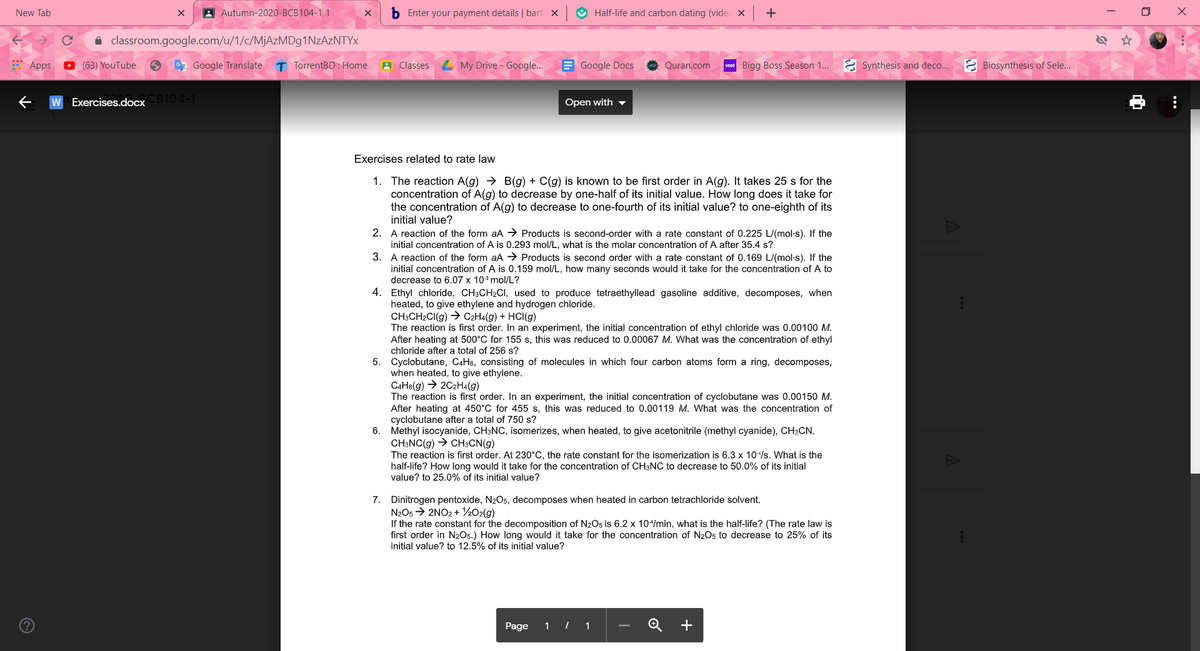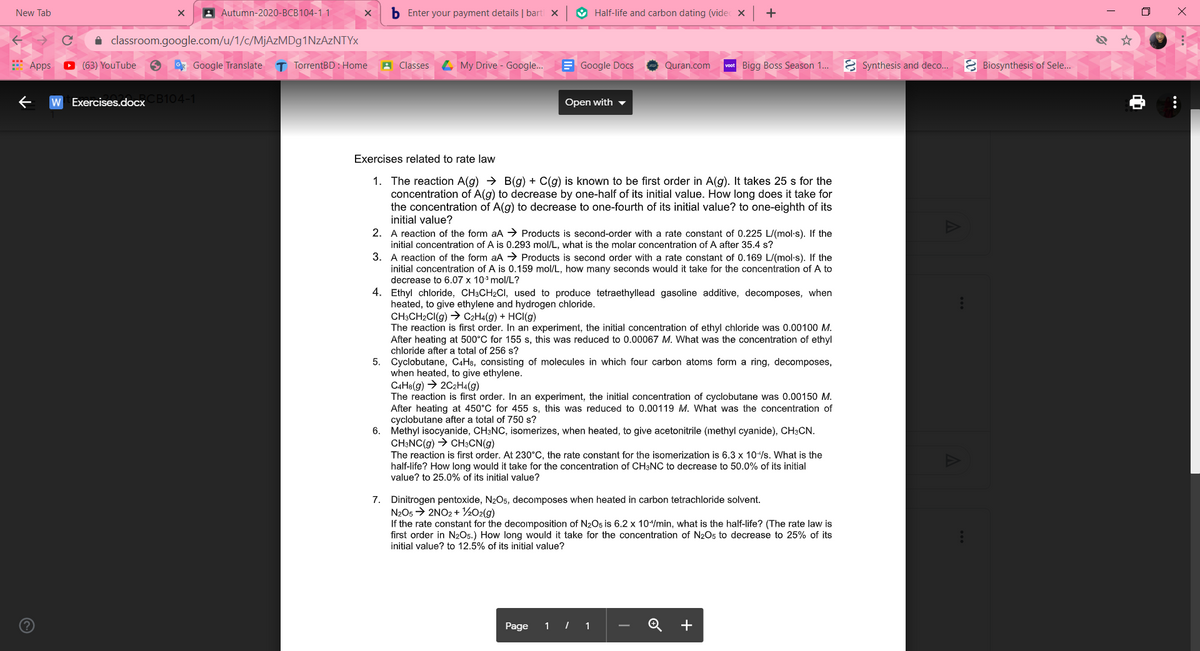The isomerization of cyclopropane, C3H6, to propylene, CH2=CHCH3, is first order in cyclopropane and first order overall. At 1000°C, the rate constant is 9.2/s. What is the half-life of cyclopropane at 1000 °C? How long would it take for the concentration of cyclopropane to decrease to 50% of its initial value? to 25% of its initial value?
The isomerization of cyclopropane, C3H6, to propylene, CH2=CHCH3, is first order in cyclopropane and first order overall. At 1000°C, the rate constant is 9.2/s. What is the half-life of cyclopropane at 1000 °C? How long would it take for the concentration of cyclopropane to decrease to 50% of its initial value? to 25% of its initial value?
Chemistry: The Molecular Science
5th Edition
ISBN:9781285199047
Author:John W. Moore, Conrad L. Stanitski
Publisher:John W. Moore, Conrad L. Stanitski
Chapter18: Nuclear Chemistry
Section: Chapter Questions
Problem 91QRT
Related questions
Question
The isomerization of cyclopropane, C3H6, to propylene, CH2=CHCH3, is first order in cyclopropane and first order overall. At 1000°C, the rate constant is 9.2/s. What is the half-life of cyclopropane at 1000 °C? How long would it take for the concentration of cyclopropane to decrease to 50% of its initial value? to 25% of its initial value?

Transcribed Image Text:New Tab
A Autumn-2020-BCB104-1 1
b Enter your payment details | bart x
& Half-life and carbon dating (videc x
+
i classroom.google.com/u/1/c/MJAZMD91NZAZNTYX
E Apps
O (63) YouTube
9 * Google Translate
T TorrentBD : Home
A Classes
L My Drive - Google...
E Google Docs
Quran.com
voot Bigg Boss Season 1..
E Synthesis and deco.
8 Biosynthesis of Sele.
W Exercises.docx B104-1
Open with ▼
Exercises related to rate law
1. The reaction A(g) → B(g) + C(g) is known to be first order in A(g). It takes 25 s for the
concentration of A(g) to decrease by one-half of its initial value. How long does it take for
the concentration of A(g) to decrease to one-fourth of its initial value? to one-eighth of its
initial value?
2. A reaction of the form aA > Products is second-order with a rate constant of 0.225 L/(mol-s). If the
initial concentration of A is 0.293 mol/L, what is the molar concentration of A after 35.4 s?
3. A reaction of the form aA → Products is second order with a rate constant of 0.169 L/(mol-s). If the
initial concentration of A is 0.159 mol/L, how many seconds would it take for the concentration of A to
decrease to 6.07 x 10° mol/L?
4. Ethyl chloride, CH3CH2CI, used to produce tetraethyllead gasoline additive, decomposes, when
heated, to give ethylene and hydrogen chloride.
CH3CH2CI(g) → C2H4(g) + HCI(g)
The reaction is first order. In an experiment, the initial concentration of ethyl chloride was 0.00100 M.
After heating at 500°C for 155 s, this was reduced to 0.00067 M. What was the concentration of ethyl
chloride after a total of 256 s?
5. Cyclobutane, C4H8, consisting of molecules in which four carbon atoms form a ring, decomposes,
when heated, to give ethylene.
CAH8(g) → 2C2H4(g)
The reaction is first order. In an experiment, the initial concentration of cyclobutane was 0.00150 M.
After heating at 450°C for 455 s, this was reduced to 0.00119 M. What was the concentration of
cyclobutane after a total of 750 s?
6. Methyl isocyanide, CH3NC, isomerizes, when heated, to give acetonitrile (methyl cyanide), CH3CN.
CH3NC(g) > CH3CN(g)
The reaction is first order. At 230°C, the rate constant for the isomerization is 6.3 x 10/s. What is the
half-life? How long would it take for the concentration of CH3NC to decrease to 50.0% of its initial
value? to 25.0% of its initial value?
7. Dinitrogen pentoxide, N2O5, decomposes when heated in carbon tetrachloride solvent.
N2O5 > 2NO2 + ½O2(g)
If the rate constant for the decomposition of N2O5 is 6.2 x 10/min, what is the half-life? (The rate law is
first order in N2O5.) How long would it take for the concentration of N2O5 to decrease to 25% of its
initial value? to 12.5% of its initial value?
Page
1 | 1
...

Transcribed Image Text:New Tab
A Autumn-2020-BCB104-1 1
b Enter your payment details | bart x
& Half-life and carbon dating (videc x
+
i classroom.google.com/u/1/c/MJAZMD91NZAZNTYX
E Apps
O (63) YouTube
9 * Google Translate
T TorrentBD : Home
A Classes
L My Drive - Google...
E Google Docs
Quran.com
voot Bigg Boss Season 1..
E Synthesis and deco.
8 Biosynthesis of Sele.
W Exercises.docx B104-1
Open with ▼
Exercises related to rate law
1. The reaction A(g) → B(g) + C(g) is known to be first order in A(g). It takes 25 s for the
concentration of A(g) to decrease by one-half of its initial value. How long does it take for
the concentration of A(g) to decrease to one-fourth of its initial value? to one-eighth of its
initial value?
2. A reaction of the form aA > Products is second-order with a rate constant of 0.225 L/(mol-s). If the
initial concentration of A is 0.293 mol/L, what is the molar concentration of A after 35.4 s?
3. A reaction of the form aA → Products is second order with a rate constant of 0.169 L/(mol-s). If the
initial concentration of A is 0.159 mol/L, how many seconds would it take for the concentration of A to
decrease to 6.07 x 10° mol/L?
4. Ethyl chloride, CH3CH2CI, used to produce tetraethyllead gasoline additive, decomposes, when
heated, to give ethylene and hydrogen chloride.
CH3CH2CI(g) → C2H4(g) + HCI(g)
The reaction is first order. In an experiment, the initial concentration of ethyl chloride was 0.00100 M.
After heating at 500°C for 155 s, this was reduced to 0.00067 M. What was the concentration of ethyl
chloride after a total of 256 s?
5. Cyclobutane, C4H8, consisting of molecules in which four carbon atoms form a ring, decomposes,
when heated, to give ethylene.
CAH8(g) → 2C2H4(g)
The reaction is first order. In an experiment, the initial concentration of cyclobutane was 0.00150 M.
After heating at 450°C for 455 s, this was reduced to 0.00119 M. What was the concentration of
cyclobutane after a total of 750 s?
6. Methyl isocyanide, CH3NC, isomerizes, when heated, to give acetonitrile (methyl cyanide), CH3CN.
CH3NC(g) > CH3CN(g)
The reaction is first order. At 230°C, the rate constant for the isomerization is 6.3 x 10/s. What is the
half-life? How long would it take for the concentration of CH3NC to decrease to 50.0% of its initial
value? to 25.0% of its initial value?
7. Dinitrogen pentoxide, N2O5, decomposes when heated in carbon tetrachloride solvent.
N2O5 > 2NO2 + ½O2(g)
If the rate constant for the decomposition of N2O5 is 6.2 x 10/min, what is the half-life? (The rate law is
first order in N2O5.) How long would it take for the concentration of N2O5 to decrease to 25% of its
initial value? to 12.5% of its initial value?
Page
1 | 1
...
Expert Solution
This question has been solved!
Explore an expertly crafted, step-by-step solution for a thorough understanding of key concepts.
This is a popular solution!
Trending now
This is a popular solution!
Step by step
Solved in 3 steps with 3 images

Knowledge Booster
Learn more about
Need a deep-dive on the concept behind this application? Look no further. Learn more about this topic, chemistry and related others by exploring similar questions and additional content below.Recommended textbooks for you

Chemistry: The Molecular Science
Chemistry
ISBN:
9781285199047
Author:
John W. Moore, Conrad L. Stanitski
Publisher:
Cengage Learning

Principles of Modern Chemistry
Chemistry
ISBN:
9781305079113
Author:
David W. Oxtoby, H. Pat Gillis, Laurie J. Butler
Publisher:
Cengage Learning

Chemistry
Chemistry
ISBN:
9781305957404
Author:
Steven S. Zumdahl, Susan A. Zumdahl, Donald J. DeCoste
Publisher:
Cengage Learning

Chemistry: The Molecular Science
Chemistry
ISBN:
9781285199047
Author:
John W. Moore, Conrad L. Stanitski
Publisher:
Cengage Learning

Principles of Modern Chemistry
Chemistry
ISBN:
9781305079113
Author:
David W. Oxtoby, H. Pat Gillis, Laurie J. Butler
Publisher:
Cengage Learning

Chemistry
Chemistry
ISBN:
9781305957404
Author:
Steven S. Zumdahl, Susan A. Zumdahl, Donald J. DeCoste
Publisher:
Cengage Learning


Chemistry: An Atoms First Approach
Chemistry
ISBN:
9781305079243
Author:
Steven S. Zumdahl, Susan A. Zumdahl
Publisher:
Cengage Learning

Principles of Instrumental Analysis
Chemistry
ISBN:
9781305577213
Author:
Douglas A. Skoog, F. James Holler, Stanley R. Crouch
Publisher:
Cengage Learning